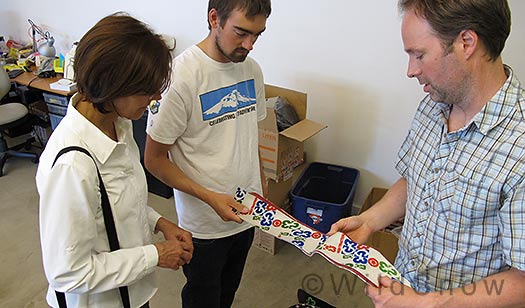Testosterone. Some say the legendary chemical causes wars, unplanned pregnancies and nearly every other detrimental condition known to mankind.
I’d include death-wall steep skin tracks in that list.
The evidence is clear. Some of you guys like to go straight up hill, even to the point of leaving your partners behind slipping and sliding, sometimes even resorting to setting their own switchbacks as you forge upward on your oblivious path of manly destiny. Even so, everyone seems to come back smiling, to dig out brews from the trailhead snowbank and laugh about how funny it looked when Bill skied backwards down the skin track at 20 mph with his skins on. More, before you scour me in the blog comments, it’s true that sometimes a steeper track is practical, such as when setting odd lines to avoid avalanche danger, or when breaking trail in snow so deep it clogs your ears on the up track (Hokkaido, it’s on the list).

Rob Moore (right) shows Louie and Lisa Dawson the new Alpinist High Traction skins. Note the new graphics, specific to this model.
So, for those of you whose skin tracks could easily become ice climbing routes, enter G3 High Traction skins.
During our recent PNW travels, we managed a stop by G3’s headquarters in Vancouver, Canada. Product developer and engineer Rob Moore showed us around (more on that in another post), but as I know many of you WildSnow readers are especially interested in climbing skin technology, here’s a quick report about just the skins.
First, know that G3 makes all their climbing skins in-house, meaning they get contracted textiles from overseas, formulate and job out the making of their glue, but put everything together right there in Vancouver. As with many small manufacturing operations, doing it that way has its economic downsides compared to overseas manufacturing, but is terrific when it comes to quality control. One thing about G3 — despite a few hiccups now and then, they obviously don’t skimp on quality.
Alpinist High Traction (HT) skins are said to be about 20% more grippy (depending on snow conditions) and have noticeably, though not excessively, less glide. In our skin testing over the years, we’ve noticed that the regular G3 Alpinst skins glide incredibly well for nylons, but do lack a slight bit in the traction department. I asked Rob about this. He said it’s not that tough to spec out nylon skin material that has different ratios of glide vs traction, and the regular Alpinist hit a sweet spot for a lot of backcountry skiers. Hence, they won’t be changing the regular skin — simply offering the HT version.
A few issues come to mind regarding this sort of climbing skin. If only one person in a group has HT skins during a trail break, what good is he if other skiers can’t follow? Thus, will the Alpinist High Traction skin drive a trend to this sort of fur, instead ofglide-optimized mohair type carpets? Will we be carrying two pairs of skins in our backpacks: one for the approach, and one for the climb? Interesting times.
Look for Alpinist High Traction skins this fall at your favorite shopping venue. If you need more testosterone, I’ve heard it’s available on the market as well.
WildSnow.com publisher emeritus and founder Lou (Louis Dawson) has a 50+ years career in climbing, backcountry skiing and ski mountaineering. He was the first person in history to ski down all 54 Colorado 14,000-foot peaks, has authored numerous books about about backcountry skiing, and has skied from the summit of Denali in Alaska, North America’s highest mountain.
